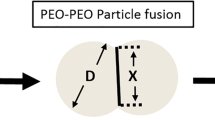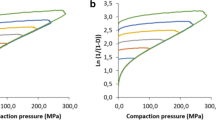Abstract
This study aimed to investigate the effects of dry and humid heat curing on the physical and drug release properties of polyvinyl acetate–polyvinyl pyrrolidone matrices. Both conditions resulted in increased tablet hardness; tablets stored under humid conditions showed high plasticity and deformed during hardness testing. Release from the matrices was dependent on the filler's type and level. Release profiles showed significant changes, as a result of exposure to thermal stress, none of the fillers used stabilized matrices against these changes. Density of neat polymeric compacts increased upon exposure to heat; the effect of humid heat was more evident than dry heat. Thermograms of samples cured under dry heat did not show changes, while those of samples stored under high humidity showed significant enlargement of the dehydration endotherm masking the glass transition of polyvinyl acetate. The change of the physical and release properties of matrices could be explained by the hygroscopic nature of polyvinyl pyrrolidone causing water uptake; absorbed water then acts as a plasticizer of polyvinyl acetate promoting plastic flow, deformation, and coalescence of particles, and altering the matrices internal structure. Results suggest that humid heat is more effective as a curing environment than dry heat for polyvinyl acetate–polyvinyl pyrrolidone matrices.










Similar content being viewed by others
References
Colombo R, Bettini R, Santi P, Peppas NA. Swellable matrices for controlled drug delivery: gel-layer behaviour, mechanisms and optical performance. Pharm Sci Technol Today. 2000;3:198–204.
Kanjickal DG, Lopina ST. Modeling of drug release from polymeric delivery systems—a review. Crit Rev Therap Drug Carrier Syst. 2004;21:345–86.
Reynolds TD, Gehrke SH, Hussain AS, Shenouda LS. Polymer erosion and drug release characterization of hydroxypropyl methylcellulose matrices. J Pharm Sci. 1998;87:1115–23.
Kavanagh N, Corrigan OI. Swelling and erosion properties of hydroxypropylmethylcellulose (Hypromellose) matrices—influence of agitation rate and dissolution medium composition. Int J Pharm. 2004;279:141–52.
Farhad T, Abrahmsen-Alami S, Hansen M, Larsson A. The impact of dose and solubility of additives on the release from HPMC matrix tablets-identifying critical conditions. Pharm Res. 2009;26(6):1496–503.
Li CL, Martini LG, Ford JL, Roberts M. The use of hypromellose in oral drug delivery. J Pharmacy Pharmacol. 2005;57(5):533–46.
Khan GM, Zhu J. Studies on drug release kinetics from ibuprofen-carbomer hydrophilic matrix tablets: influence of co-excipients on release rate of the drug. J Control Release. 1999;57(2):197–203.
Khan GM, Meidan VM. Drug release kinetics from tablet matrices based upon ethylcellulose ether-derivatives: a comparison between different formulations. Drug Dev Ind Pharm. 2007;33(6):627–39.
Gallardo D, Skalsky B, Kleinebudde P. Controlled release solid dosage forms using combinations of (meth)acrylate copolymers. Pharm Dev Technol. 2008;13(5):413–23.
Tapia C, Escobar Z, Costa E, Sapag-Hagar J, Valenzuela F, Basualto C, et al. Comparative studies on polyelectrolyte complexes and mixtures of chitosan-alginate and chitosan-carrageenan as prolonged diltiazem clorhydrate release systems. Eur J Pharm Biopharm. 2004;57(1):65–75.
Bühler V, Kollidon SR. In Kollidon®—polyvinylpyrrolidone in pharmaceutical industry. 9th Ed. Ludwigshafen: BASF SE; 2008. p. 255–70.
Draganoiu E, Andheria M, Sakr A. Evaluation of the new polyvinyl acetate/povidone excipient for matrix sustained release dosage forms. Pharm Ind. 2001;63(6):624–9.
Shao ZJ, Farooqi MI, Diaz S, Krishna AK, Muhammad NA. Effects of formulation variables and post-compression curing on drug release from a new sustained-release matrix material: poly(vinyl acetate)–povidone. Pharm Dev Technol. 2001;6(2):247–54.
Kranz H, Wagner T. Effects of formulation and process variables on the release of a weakly basic drug from single unit extended release formulations. Eur J Pharm Biopharm. 2006;62(1):70–6.
Kranz H, Guthmann C, Wagner T, Lipp R, Reinhard J. Development of a single unit extended release formulation for ZK 811 752, a weakly basic drug. Eur J Pharm Sci. 2005;26(1):47–53.
Omelczuk MO, McGinity JW. The influence of thermal treatment on the physical–mechanical and dissolution properties of tablets containing poly (DL lactic acid). Pharm Res. 1993;10(4):542–8.
Zhu Y, Shah NH, Malick AW, Infeld MH, McGinity JW. Influence of thermal processing on the properties of chlorpheniramine maleate tablets containing an acrylic polymer. Pharm Dev Technol. 2002;7(4):481–9.
AlKhatib HS, Sakr A. Modeling of the effect of triethyl citrate and curing on drug release from film coated tablets. Pharm Ind. 2005;67(2):237–42.
Engineer S, Shao ZJ, Khagani NA. Temperature/humidity sensitivity of sustained-release formulations containing Kollidon SR. Drug Dev Ind Pharm. 2004;30(10):1089–94.
Higuchi T. Mechanism of sustained-action medication: theoretical analysis of rate of release of solid drugs dispersed in solid matrices. J Pharm Sci. 1963;52:1145–9.
Siepmann J, Peppas NA. Modeling of drug release from delivery systems based on hydroxypropyl methylcellulose (HPMC). Adv Drug Deliver Rev. 2001;48(2–3):139–57.
Körber M, Hoffart V, Walther M, Macrae RJ, Bodmeier R. Effect of unconventional curing conditions and storage on pellets coated with Aquacoat ECD. Drug Dev Ind Pharm. 2010;36(2):190-199.
Sadek HM, Olsen JL. Determination of water-adsorption isotherms of hydrophilic polymers. Pharm Technol. 1981;5(2):42–8. 40.
Callahan JC, Cleary GW, Elefant M, Kaplan G, Kensler T, Nash RA. Equilibrium moisture content of pharmaceutical excipients. Drug Dev Ind Pharm. 1982;8(3):355–69.
Zhang F, McGinity JW. Properties of hot-melt extruded theophylline tablets containing poly (vinyl acetate). Drug Dev Ind Pharm. 2000;26(9):931–42.
Gonzalez Novoa GA, Heinämäki J, Mirza S, Antikainen O, Colarte AI, Paz AS, et al. Physical solid-state properties and dissolution of sustained-release matrices of polyvinylacetate. Eur J Pharm Biopharm. 2005;59(2):343–50.
Camino G, Polishchuk AY, Luda MP, Revellino M. Comparison of the roles of two shrinkage-controlled low-profile additives in water aging of polyster resin-glass fiber composites. Polym Composites. 2000;21(5):821–31.
Aulton ME, Travers DN, White PJ. Strain recovery of compacts on extended storage. J Pharmacy Pharmacol. 1973;25(Suppl):79P–86.
Picker KM. Time dependence of elastic recovery for characterization of tableting materials. Pharm Dev Technol. 2001;6(1):61–70.
Rekhi GS, Nellore RV, Hussain AS, Tillman LG, Malinowski HJ, Augsburger LL. Identification of critical formulation and processing variables for metoprolol tartrate extended-release (ER) matrix tablets. J Control Release. 1999;59(3):327–42.
Alderman DA. A review of cellulose ethers in hydrophilic matrices for oral controlled release dosage forms. Int J Pharm Technol Prod Manuf. 1984;5:1–9.
Vueba ML, de Carvalho LA Batista, Veiga F, Sousa JJ, Pina ME. Role of cellulose ether polymers on ibuprofen release from matrix tablets. Drug Dev Ind Pharm. 2005;31(7):653–65.
Acknowledgements
The authors would like to acknowledge the financial support received from the Deanship of Scientific Research at the University of Jordan and the technical help in preparation and testing of matrices in the facilities of Triumpharma Inc., Amman, Jordan, and Specialized Pharma Inc., Amman, Jordan.
The authors also wish to acknowledge the technical help of Ms. Shorouq AlSotari, Ms. Amani Nimer, and Mr. Tareq Najjar. The authors also wish to thank Ms. Suha Muhaissen for help in taking photographs of tested tablets.
Author information
Authors and Affiliations
Corresponding author
Rights and permissions
About this article
Cite this article
AlKhatib, H.S., Hamed, S., Mohammad, M.K. et al. Effects of Thermal Curing Conditions on Drug Release from Polyvinyl Acetate–Polyvinyl Pyrrolidone Matrices. AAPS PharmSciTech 11, 253–266 (2010). https://doi.org/10.1208/s12249-010-9378-z
Received:
Accepted:
Published:
Issue Date:
DOI: https://doi.org/10.1208/s12249-010-9378-z




